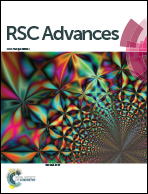Anti-inflammatory sesquiterpenes from the medicinal herb Tanacetum sinaicum†
Abstract
New sesquiterpenes tanacetolide A–C (1–3) were isolated from a Tanacetum sinaicum extract together with known compounds (4–10). The structures were elucidated on the basis of MS and NMR spectroscopic data. All the compounds were evaluated for the inhibition of inducible nitric oxide (NO) production in a mouse peritoneal macrophage system. Iso-seco-tanapartholide-3-O-methyl ether (4) produced potent inhibition of NO production (IC50 = 1.0 μM). At the protein expression level, 4 elicited concentration-dependant down-regulation of inducible nitric oxide synthase.


 Please wait while we load your content...
Please wait while we load your content...